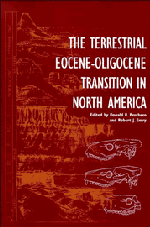Book contents
- Frontmatter
- Contents
- Contributors
- Preface
- PART I The Chronostratigraphy of the Uintan through Arikareean
- PART II Common Vertebrates of the White River Chronofauna
- 16 Testudines
- 17 Squamata
- 18 Ischyromyidae
- 19 Cylindrodontidae
- 20 Castoridae
- 21 Canidae
- 22 Nimravidae
- 23 Amphicyonidae
- 24 Small Arctoid and Feliform Camivorans
- 25 Merycoidodontinae and Miniochoerinae
- 26 Leptaucheniinae
- 27 Leptomerycidae
- 28 Camelidae
- 29 Hyracodontidae
- Summary
- Index
27 - Leptomerycidae
Published online by Cambridge University Press: 06 July 2010
- Frontmatter
- Contents
- Contributors
- Preface
- PART I The Chronostratigraphy of the Uintan through Arikareean
- PART II Common Vertebrates of the White River Chronofauna
- 16 Testudines
- 17 Squamata
- 18 Ischyromyidae
- 19 Cylindrodontidae
- 20 Castoridae
- 21 Canidae
- 22 Nimravidae
- 23 Amphicyonidae
- 24 Small Arctoid and Feliform Camivorans
- 25 Merycoidodontinae and Miniochoerinae
- 26 Leptaucheniinae
- 27 Leptomerycidae
- 28 Camelidae
- 29 Hyracodontidae
- Summary
- Index
Summary
ABSTRACT
Leptomerycids appear in North America in the late Duchesnean and extend into the Arikareean. The earliest grade, called Hendryomeryx by some workers, differs from later Leptomeryx in having lower crowned cheek teeth. Leptomeryx yoderi appeared in the early Chadronian and became a widespread species. This small but high crowned species probably gave rise to all later species of Leptomeryx. At Flagstaff Rim, Wyoming, L. yoderi underwent a gradual anagenetic size increase to become L. mammifer of the middle to late Chadronian. Leptomeryx speciosus probably also descended from L. yoderi. Leptomeryx yoderi and L. speciosus are of similar size and differ only in the shape of the entoconulid on the last molar. Both L. Speciosus and L. mammifer became widespread species and are found at Pipestone Springs, Montana, and in the Cypress Hills, Saskatchewan. Leptomeryx mammifer went extinct before the end of the Chadronian, leaving L. speciosus as the only known surviving species. At Douglas, Wyoming, L. speciosus can be seen undergoing gradual anagenesis across the Chadronian-Orellan boundary to become L. evansi, the type species of the genus. Leptomeryx evansi is probably the only valid Orellan species, and it is found in great numbers in the Big Badlands of South Dakota and at other Orellan exposures of the Great Plains.
- Type
- Chapter
- Information
- The Terrestrial Eocene-Oligocene Transition in North America , pp. 581 - 608Publisher: Cambridge University PressPrint publication year: 1996
- 5
- Cited by



